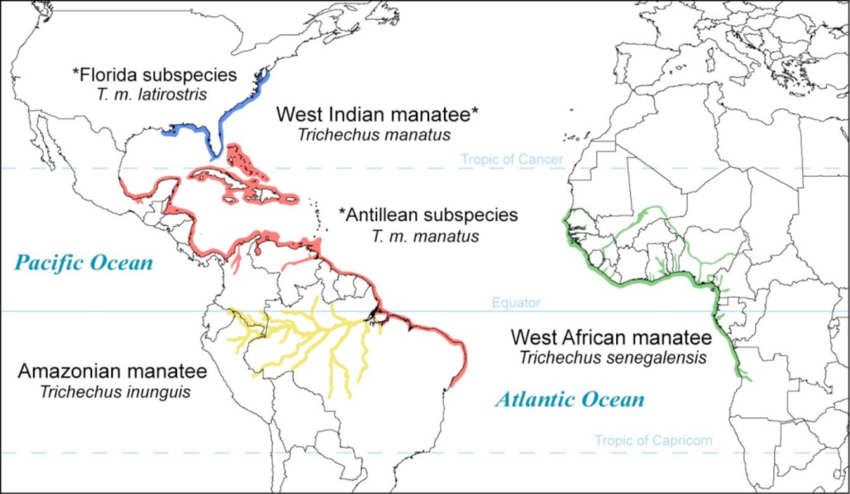Manatees, the gentle giants of the sea, have captured the hearts of many with their peaceful nature and curious behavior. These fascinating creatures can be found in various locations around the world, each species adapting to its unique environment. In this article, we'll explore the different habitats where manatees live and what makes these areas suitable for their survival.
The Three Species of Manatees and Their Habitats
There are three distinct species of manatees, each inhabiting a specific region:
West Indian Manatee (Trichechus manatus): Found in the Caribbean Sea, Gulf of Mexico, and the southeastern United States, particularly Florida. They live in saltwater and freshwater environments, such as coastal areas, estuaries, and rivers.
Amazonian Manatee (Trichechus inunguis): As the name suggests, this species is found exclusively in the Amazon River Basin, spanning Brazil, Colombia, Ecuador, and Peru. They are the only manatee species that live solely in freshwater.
West African Manatee (Trichechus senegalensis): Inhabiting the western coast of Africa, these manatees can be found in countries like Senegal, Liberia, and Nigeria. They primarily reside in estuaries, lagoons, and mangrove habitats.
Geographic distribution of extant manatee species. Range data adapted from IUCN (researchgate.net)
Factors That Influence Manatee Habitats
Manatees require specific environmental conditions to thrive, and their habitats are determined by several key factors:
Warm Water Temperatures
Manatees are sensitive to cold temperatures and cannot tolerate waters below 68°F (20°C) for extended periods. As a result, they are found in tropical and subtropical regions where the water remains warm year-round. In the United States, manatees often congregate near natural springs or power plant outflows during colder months to stay warm.
Shallow, Slow-Moving Waters
Manatees prefer shallow, slow-moving waters that allow them to easily navigate and access their primary food source – aquatic vegetation. They are often found in coastal areas, estuaries, bays, and rivers where they can find an abundance of seagrass and other aquatic plants.
Proximity to Food Sources
As herbivores, manatees require a constant supply of aquatic vegetation to survive. Their habitats are typically located near seagrass beds, mangrove forests, and other areas rich in aquatic plants. The Amazonian Manatee, for example, relies on the lush vegetation found in the Amazon River Basin.
Migration Patterns and Seasonal Movements
Manatees are known to migrate and move between habitats depending on the season and water temperatures. In the United States, West Indian Manatees often travel northward along the Atlantic coast during summer and return to Florida for the winter. Some manatees have been recorded traveling as far north as Massachusetts.
Amazonian Manatees also exhibit seasonal movements within the Amazon River Basin. During the wet season, they disperse into flooded forests and tributaries to feed on abundant vegetation. As the dry season approaches and water levels drop, they return to the main river channels.
Conservation and Protection of Manatee Habitats
Manatee populations have been threatened by human activities such as hunting, habitat destruction, and boat collisions. To ensure their survival, it is crucial to protect and preserve the habitats that manatees depend on. Conservation efforts include:
Establishing protected areas and sanctuaries
Regulating boat speeds in manatee habitats
Restoring and maintaining healthy aquatic ecosystems
Raising awareness about the importance of manatee conservation
By understanding and safeguarding the habitats where manatees live, we can help ensure a future for these gentle giants and the ecosystems they call home.

